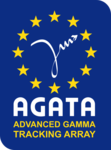Speaker
Description
Shell evolution of neutron-deficient Xe isotopes:
Quadrupole and Octupole Collectivity above 100Sn
Status of the Analysis of the Experiment E730 performed with the
AGATA-NEDA-DIAMANT-OUPS set-up
M.L. Jurado-Gómez, IFIC, Spain E.Clément, GANIL, France, A.Gadea, IFIC, Spain J.J. Valiente-Dobón, INFN-LNL, Legnaro, Italy.
The region that lies just above the Z=50 closed shell in the vicinity of 100Sn exhibits original collective behaviors. With the development of collectivity when adding protons in the g7/2 shell, shape coexisting structures, strong octupole correlations and strong neutron-proton couplings arise. With this experiment, we aim to address specific aspects of the collectivity development when approaching the N=Z line in light Xe isotopes by performing a precise lifetime measurement of excited states in 112Xe. The quadrupole degree of freedom, relevant to investigate the neutron-proton correlations [1], will be investigated through the lifetime of the 2+ and 4+. Additionally the lifetime of the 5- state, possibly together with information on branching ratios, might help address the question of the enhancement of the octupole correlation in the neighborhood of 112Ba[2].
The experiment was performed at the AGATA-NEDA-DIAMANT setup installed at the GANIL laboratory, with the CSNSM “OUPS” plunger device [3]. The 112Xe nuclei was populated in a compound nucleus reaction with a 58Ni beam impinging on a 58Ni 1 mg/cm2 target in the 2 proton 2 neutron evaporation channel. A 197Au degrader with a thickness of 5 mg/cm2 was installed in the plunger device to degrade the reaction products energy without stopping them, in order to maximize the sensibility. The detection on at least a neutron in NEDA+Neutron Wall [4] in coincidence with a gamma-ray in AGATA [5,6] was used as trigger while the information of DIAMANT was used off-line for identification and selection of the particle emitting channels. Nine Target-Degrader distances, ranging from 22 to 1500 micrometers, have been used to determine the lifetimes of interest.
The calibration, alignment, definition of the neutrons and light charged particle conditions and final sorting of the data was completed before the end of 2019.
In this contribution, we will report on the on the status of the analysis and the preliminary findings.
[1] M. Sandzelius et al., Phys. Rev Letters 99 (2007) 022501
[2] G. de Angelis et al., Phys. Lett. B 535 (2002) 93.
[3] J.Ljungvall et al., Nucl. Inst. and Meth. A 679 (2012) 61.
[4] J.J. Valiente-Dobón et al., Nucl. Inst. and Meth. A 927 (2019) 81.
[5] A. Akkoyun et al., Nucl. Inst. and Meth. A 668 (2012) 26.
[6] E. Clément et al., Nucl. Inst. and Meth. A 855 (2017) 1.

